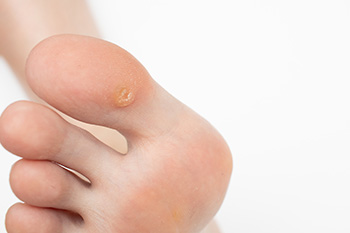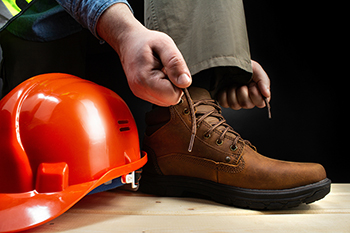Items filtered by date: June 2024
Definition and Symptoms of Plantar Warts

Plantar warts are common viral skin infections that occur on the soles of the feet, caused by the human papillomavirus, abbreviated HPV. These warts often appear as small, rough growths that can be painful when pressure is applied, such as during walking or standing. Characteristically, plantar warts may have tiny black dots on their surface, which are actually small, clotted blood vessels. The skin around the wart may become thickened or callused due to the constant friction and pressure. In some cases, plantar warts can cluster together to form mosaic warts, which can be particularly difficult to treat. Symptoms can include tenderness and discomfort, particularly when the wart is located on a weight-bearing area of the foot. The majority of people experience pain while walking with plantar warts. If this applies to you, it is suggested that you consult a podiatrist who can offer you effective relief and treatment solutions.
Plantar warts can be very uncomfortable. If you need your feet checked, contact Mohammad R. Parsa, DPM from Madison Foot Clinic. our doctor will assist you with all of your foot and ankle needs.
About Plantar Warts
Plantar warts are the result of HPV, or human papillomavirus, getting into open wounds on the feet. They are mostly found on the heels or balls of the feet.
While plantar warts are generally harmless, those experiencing excessive pain or those suffering from diabetes or a compromised immune system require immediate medical care. Plantar warts are easily diagnosed, usually through scraping off a bit of rough skin or by getting a biopsy.
Symptoms
- Lesions on the bottom of your feet, usually rough and grainy
- Hard or thick callused spots
- Wart seeds, which are small clotted blood vessels that look like little black spots
- Pain, discomfort, or tenderness of your feet when walking or standing
Treatment
- Freezing
- Electric tool removal
- Laser Treatment
- Topical Creams (prescription only)
- Over-the-counter medications
To help prevent developing plantar warts, avoid walking barefoot over abrasive surfaces that can cause cuts or wounds for HPV to get into. Avoiding direct contact with other warts, as well as not picking or rubbing existing warts, can help prevent the further spread of plantar warts. However, if you think you have developed plantar warts, speak to your podiatrist. He or she can diagnose the warts on your feet and recommend the appropriate treatment options.
If you have any questions please feel free to contact our office located in Madison, MS . We offer the newest diagnostic and treatment technologies for all your foot and ankle needs.
Causes of a Broken Toe and When to See a Podiatrist

A broken toe can result from various causes, including direct trauma, stubbing the toe against a hard surface, or dropping a heavy object on the foot. Sports injuries, accidents, and even sudden, forceful movements can also lead to a toe fracture. Common symptoms include severe pain, swelling, bruising, and difficulty walking. While minor fractures may heal with rest and home care, it is important to know when to call a podiatrist. Seek medical attention if there is intense pain, visible deformity, numbness, or if the toe is cold or pale, indicating poor blood flow. Persistent swelling and an inability to move the toe also warrant a professional evaluation. Early diagnosis and appropriate treatment is vital to prevent complications and ensure proper healing of a broken toe. If you have any of the above symptoms and believe you may have fractured your toe, it is suggested that you seek prompt attention from a podiatrist who can diagnose and treat broken toes.
Broken toes may cause a lot of pain and should be treated as soon as possible. If you have any concerns about your feet, contact Mohammad R. Parsa, DPM from Madison Foot Clinic. our doctor will treat your foot and ankle needs.
What Is a Broken Toe?
A broken toe occurs when one or more of the toe bones of the foot are broken after an injury. Injuries such as stubbing your toe or dropping a heavy object on it may cause a toe fracture.
Symptoms of a Broken Toe
- Swelling
- Pain (with/without wearing shoes)
- Stiffness
- Nail Injury
Although the injured toe should be monitored daily, it is especially important to have a podiatrist look at your toe if you have severe symptoms. Some of these symptoms include worsening or new pain that is not relieved with medication, sores, redness, or open wounds near the toe.
If you have any questions, please feel free to contact our office located in Madison, MS . We offer the newest diagnostic and treatment technologies for all your foot care needs.
Proper Footwear in the Construction Industry

In the construction industry, wearing the right shoes is not just a matter of comfort. It is an important safety consideration that can make a significant difference in preventing injuries and ensuring productivity. Construction workers are exposed to various hazards on the job, including heavy objects, sharp materials, slippery surfaces, and electrical equipment, all of which pose risks to foot safety. Wearing sturdy, supportive footwear with reinforced toe caps and slip-resistant soles can provide essential protection against these dangers. Additionally, wearing proper footwear can help prevent common foot ailments such as plantar fasciitis, foot fatigue, and musculoskeletal injuries, allowing workers to stay comfortable and focused throughout the workday. Investing in high-quality work boots that meet safety standards and fit well is essential for every construction worker, as it not only promotes personal well-being but also enhances overall job performance and efficiency. By prioritizing the importance of wearing the right shoes, construction workers can mitigate risks and reduce accidents. Suffering from a foot injury during the workday may happen as a result of wearing the wrong type of shoes. If this has happened to you, it is suggested that you consult a podiatrist who can treat foot conditions and guide you on choosing the right work shoes.
While working on the feet, it is important to take the proper care of them. For more information about working on your feet, contact Mohammad R. Parsa, DPM from Madison Foot Clinic. our doctor will treat your foot and ankle needs.
Working on Your Feet
Standing on your feet for long periods of time can cause stress and pain in your feet. Your whole body may experience change in terms of posture, back pain, bunions, callouses and or plantar warts. There are ways to avoid these conditions with proper foot care, smart choices and correct posture.
Positive Changes
Negative heeled shoe – Choosing this shoe type places the heel slightly lower than the ball of the foot. These are great for overall foot health. Find shoes that fit you correctly.
Go barefoot – Our feet were not designed to be enclosed for all hours of the day. Try to periodically expose your feet to air.
Eliminate Pain
Foot Exercises – Performing simple exercises, incorporating yoga and doing stretches are beneficial. This will allow increased blood flow to the area and muscles of the foot.
Achilles tendon – Stretching the foot out flat on the floor will relax the calf muscles and tendon. These exercises can be performed almost anywhere. Make sure you add these exercises to your daily regimen.
With a little bit of this information and knowing more about foot health, you will notice changes. Foot stretches and proper footwear will help with pain and prevent further issues.
If you have any questions please feel free to contact our office located in Madison, MS . We offer the newest diagnostic and treatment technologies for all your foot and ankle needs.
Why Live with Pain and Numbness in Your Feet?
How Podiatrists Can Help With Diabetic Foot Ulcers
 Diabetic foot ulcers are open sores or wounds that develop on the feet of individuals with diabetes. Ulcers may arise due to poor blood circulation, nerve damage known as neuropathy, and high blood sugar levels, which impair the body's ability to heal. Symptoms include redness, swelling, and drainage from the ulcer, and they may become infected if not properly treated. Some risk factors for diabetic foot ulcers are prolonged diabetes, poor glycemic control, smoking, and wearing inappropriate footwear. Additionally, foot deformities and a history of foot ulcers or amputation increase the likelihood of developing these sores. Treatment involves keeping the ulcer clean and covered, managing blood glucose levels, and taking antibiotics to prevent or treat infection. A podiatrist plays a crucial role in managing and preventing diabetic foot ulcers. They can provide routine foot care, recommend proper footwear, and offer guidance on foot hygiene. If you have diabetes and notice any foot abnormalities, it is strongly suggested that you schedule an appointment with a podiatrist to prevent complications.
Diabetic foot ulcers are open sores or wounds that develop on the feet of individuals with diabetes. Ulcers may arise due to poor blood circulation, nerve damage known as neuropathy, and high blood sugar levels, which impair the body's ability to heal. Symptoms include redness, swelling, and drainage from the ulcer, and they may become infected if not properly treated. Some risk factors for diabetic foot ulcers are prolonged diabetes, poor glycemic control, smoking, and wearing inappropriate footwear. Additionally, foot deformities and a history of foot ulcers or amputation increase the likelihood of developing these sores. Treatment involves keeping the ulcer clean and covered, managing blood glucose levels, and taking antibiotics to prevent or treat infection. A podiatrist plays a crucial role in managing and preventing diabetic foot ulcers. They can provide routine foot care, recommend proper footwear, and offer guidance on foot hygiene. If you have diabetes and notice any foot abnormalities, it is strongly suggested that you schedule an appointment with a podiatrist to prevent complications.
Wound care is an important part in dealing with diabetes. If you have diabetes and a foot wound or would like more information about wound care for diabetics, consult with Mohammad R. Parsa, DPM from Madison Foot Clinic. our doctor will assess your condition and provide you with quality foot and ankle treatment.
What Is Wound Care?
Wound care is the practice of taking proper care of a wound. This can range from the smallest to the largest of wounds. While everyone can benefit from proper wound care, it is much more important for diabetics. Diabetics often suffer from poor blood circulation which causes wounds to heal much slower than they would in a non-diabetic.
What Is the Importance of Wound Care?
While it may not seem apparent with small ulcers on the foot, for diabetics, any size ulcer can become infected. Diabetics often also suffer from neuropathy, or nerve loss. This means they might not even feel when they have an ulcer on their foot. If the wound becomes severely infected, amputation may be necessary. Therefore, it is of the upmost importance to properly care for any and all foot wounds.
How to Care for Wounds
The best way to care for foot wounds is to prevent them. For diabetics, this means daily inspections of the feet for any signs of abnormalities or ulcers. It is also recommended to see a podiatrist several times a year for a foot inspection. If you do have an ulcer, run the wound under water to clear dirt from the wound; then apply antibiotic ointment to the wound and cover with a bandage. Bandages should be changed daily and keeping pressure off the wound is smart. It is advised to see a podiatrist, who can keep an eye on it.
If you have any questions, please feel free to contact our office located in Madison, MS . We offer the newest diagnostic and treatment technologies for all your foot care needs.

